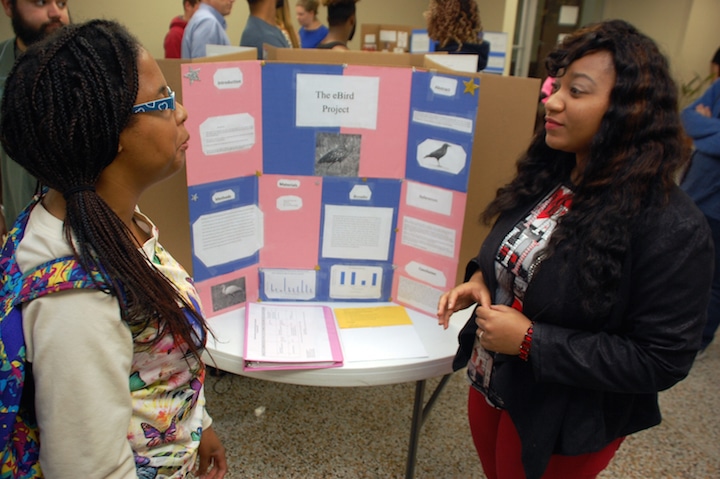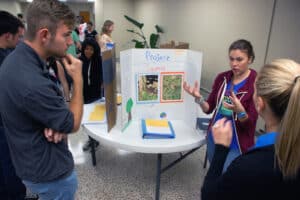
Kheyany Webb is no birdbrain.
Yet, when Yendise Collie encountered Webb Friday at the Compass Center at Beacon College in Leesburg, she quickly discovered that Collie had birds on the brain.
“Some birds are very territorial,” the Beacon freshman explained.
Collie, a junior, nodded.
“If we don’t take care of them they will vanish.”
Another nod.
“Birds only come when they feel safe.”
More nodding.
Proof positive that Webb’s eBird project — one of many exhibits on hand at the end-of–semester poster fair for the 58 students enrolled in the community-sourced science course — had helped her spread her wings as a budding naturalist.

of gray squirrels. (Photo: Darryl E. Owens)
Giving the roles of researcher and scientist a dry run echoes the academic best practices for instructing students with learning disabilities in science, said Brian Ogle, an anthrozoology instructor at Beacon, the first college or university to award bachelorÔøΩs degrees to students who learn differently, and the second in the U.S. to offer an undergraduate anthrozoology major.
The community-sourced science course requires students to collect data for regional and national citizen science projects, Ogle said.
“Their active participation not only allows them to conduct research and analyze data,” he said, “but also contributes to the body of knowledge in the scientific community as their data sets are shared with researchers.”
The fair gave students a place to highlight their semester-long environmental research projects and a platform for ecological advocacy. It also schooled them on protocols to which poster sessions adhere at professional conferences.
Visitors streamed in and out of the fair, giving presenters plenty of laypeople to educate.
Freshman Luis Castaneda, who studied native birds, shared how he grouped the many species of birds at Venetian Gardens in collating his eBird data.
At another table, it wasn’t clear whether Savannah Arner was a fan of Bullwinkle; from all appearances, however, she probably would get along swimmingly with one Rocket J. Squirrel.
To anyone who was in earshot, the freshman shared facts and anecdotes about her “Project Squirrel.”
“It was really nice. Once, I saw 15 squirrels and they were like communicating,” Arner gushed.
What kind of squirrels, she was asked — a fair question considering more than 200 squirrel species scurry out in front of cars and horse carriages all over the world.
“They were gray squirrels,” she said. “All I saw were gray squirrels.”
The rigorous fieldwork and research also fanned a fire for science. Nearly 70 percent of students who took the course agreed it helped boost their interest in science, while 81 percent said they were more likely to engage in conservation-related activities.
Indeed, Webb concedes before taking the class she “really didn’t like birds or wasn’t interested.”
That disaffection soon dissipated when she got out into the field.
“Birds are very unique,” said the 21-year-old human services major. “To me, birds are very sensitive to a lot of things and how you treat them is very important. People don’t realize how important birds are to our community and mean so much to our environment.
“All people do pretty much is destroy them.”
Maybe before.
Not on Webb’s watch.